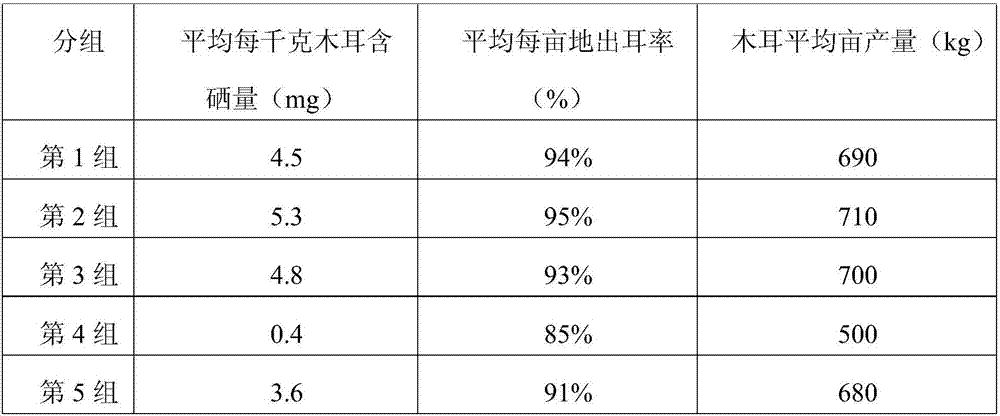Culture method of selenium-rich edible fungus
A cultivation method and technology of fungus, applied in the cultivation field of selenium-enriched fungus, can solve the problems of affecting the yield and nutritional value of fungus, lack of planting fertilizer resources, and single nutritional components, so as to promote healthy growth, rich nutritional components, and source wide effect
- Summary
- Abstract
- Description
- Claims
- Application Information
AI Technical Summary
Problems solved by technology
Method used
Image
Examples
Embodiment 1
[0027] A method for cultivating selenium-enriched fungus, comprising the following steps:
[0028] (1) Ingredients: Each raw material includes the following raw materials in parts by weight: 32 parts of chicken manure, 31 parts of duck manure, 35 parts of pig manure, 26 parts of selenium-enriched corncob powder, 22 parts of wheat bran, 30 parts of bean dregs, humus 18 parts of acid, 20 parts of bone meal, 31 parts of volcanic slag, 12 parts of lotus seed skin, 8 parts of garlic, 27 parts of mangosteen husk powder, 23 parts of black wolfberry residue, 11 parts of waste tea leaves, 20 parts of expired milk and 12 parts of purple potato powder. Among them, the black wolfberry residue is the residue left after the black wolfberry is soaked in water or wine. The above raw materials are mixed and stirred evenly, and then mixed with water for secondary stirring. The amount of water added accounts for 55% of the total mass of each raw material. During the secondary stirring, a turbine...
Embodiment 2
[0036] A method for cultivating selenium-enriched fungus, comprising the following steps:
[0037] (1) Ingredients: Each raw material includes the following raw materials in parts by weight: 47 parts of chicken manure, 36 parts of duck manure, 45 parts of pig manure, 31 parts of selenium-enriched corncob powder, 27 parts of wheat bran, 40 parts of bean dregs, humus 23 parts of acid, 26 parts of bone meal, 41 parts of volcanic slag, 17 parts of lotus seed skin, 11 parts of garlic, 32 parts of mangosteen shell powder, 28 parts of black wolfberry residue, 14.5 parts of waste tea leaves, 24 parts of expired milk and 18 parts of purple sweet potato powder. Among them, the black wolfberry residue is the residue left after the black wolfberry is soaked in water or wine. The above raw materials are mixed and stirred evenly, and then mixed with water for secondary stirring. The amount of water added accounts for 60% of the total mass of each raw material. During the secondary stirring, a...
Embodiment 3
[0045] A method for cultivating selenium-enriched fungus, comprising the following steps:
[0046] (1) Ingredients: Each raw material includes the following raw materials in parts by weight: 62 parts of chicken manure, 41 parts of duck manure, 55 parts of pig manure, 36 parts of selenium-enriched corncob powder, 32 parts of wheat bran, 50 parts of bean dregs, humus 28 parts of acid, 32 parts of bone meal, 51 parts of volcanic slag, 22 parts of lotus seed skin, 14 parts of garlic, 37 parts of mangosteen shell powder, 33 parts of black wolfberry residue, 18 parts of waste tea leaves, 28 parts of expired milk and 24 parts of purple sweet potato powder. Among them, the black wolfberry residue is the residue left after the black wolfberry is soaked in water or wine. The above raw materials are mixed and stirred evenly, and then mixed with water for secondary stirring. The amount of water added accounts for 65% of the total mass of each raw material. During the secondary stirring, a...
PUM
 Login to View More
Login to View More Abstract
Description
Claims
Application Information
 Login to View More
Login to View More - R&D
- Intellectual Property
- Life Sciences
- Materials
- Tech Scout
- Unparalleled Data Quality
- Higher Quality Content
- 60% Fewer Hallucinations
Browse by: Latest US Patents, China's latest patents, Technical Efficacy Thesaurus, Application Domain, Technology Topic, Popular Technical Reports.
© 2025 PatSnap. All rights reserved.Legal|Privacy policy|Modern Slavery Act Transparency Statement|Sitemap|About US| Contact US: help@patsnap.com

